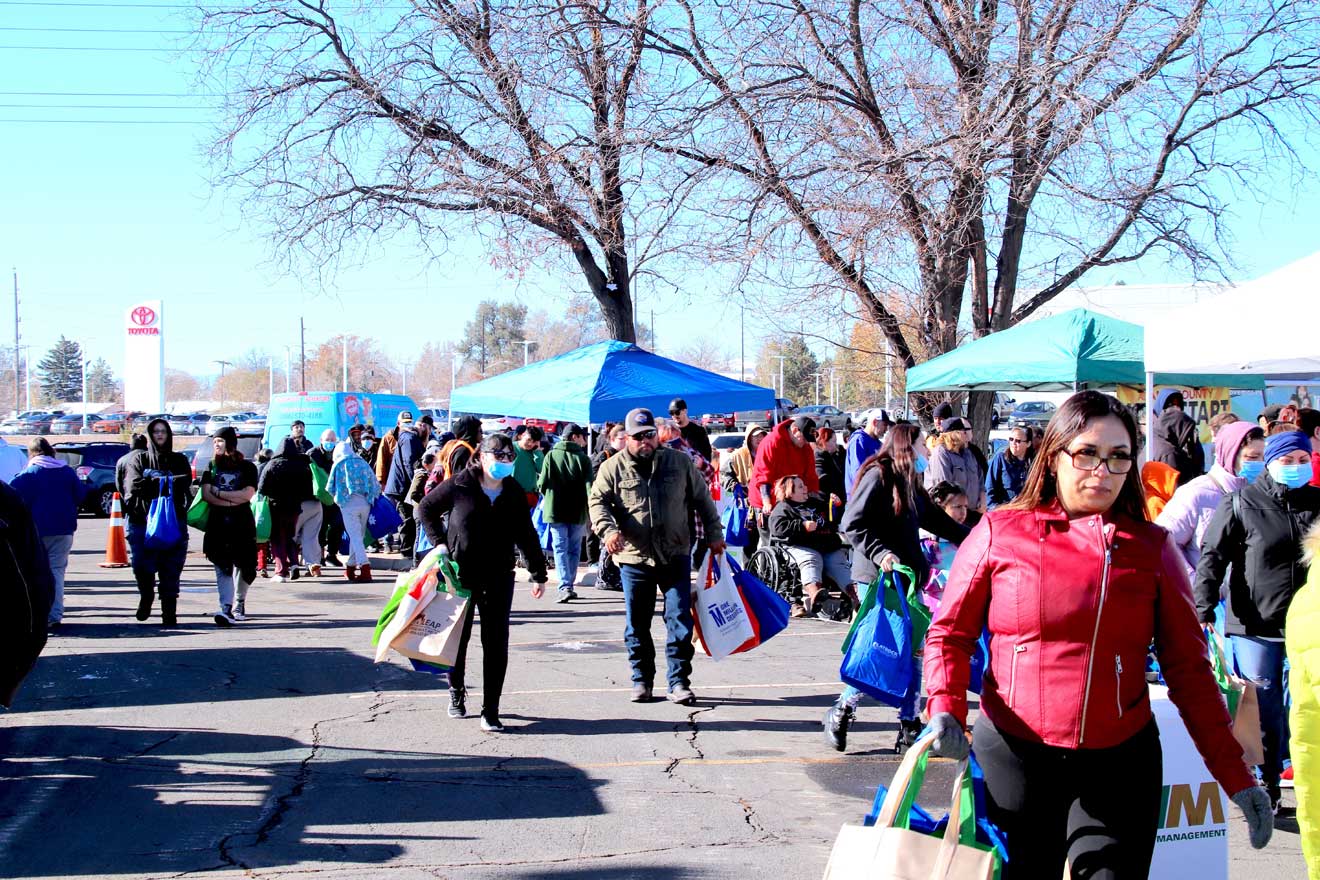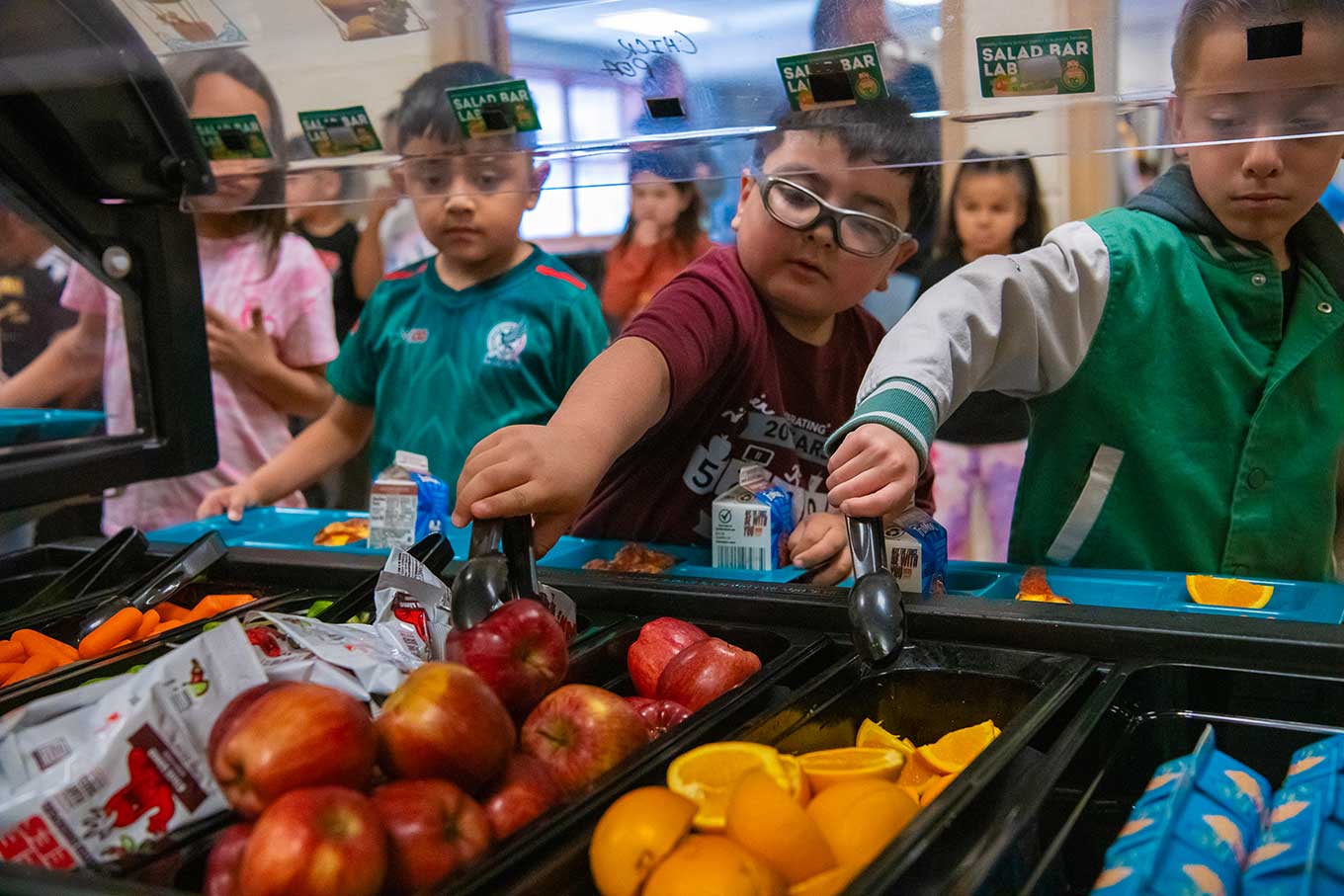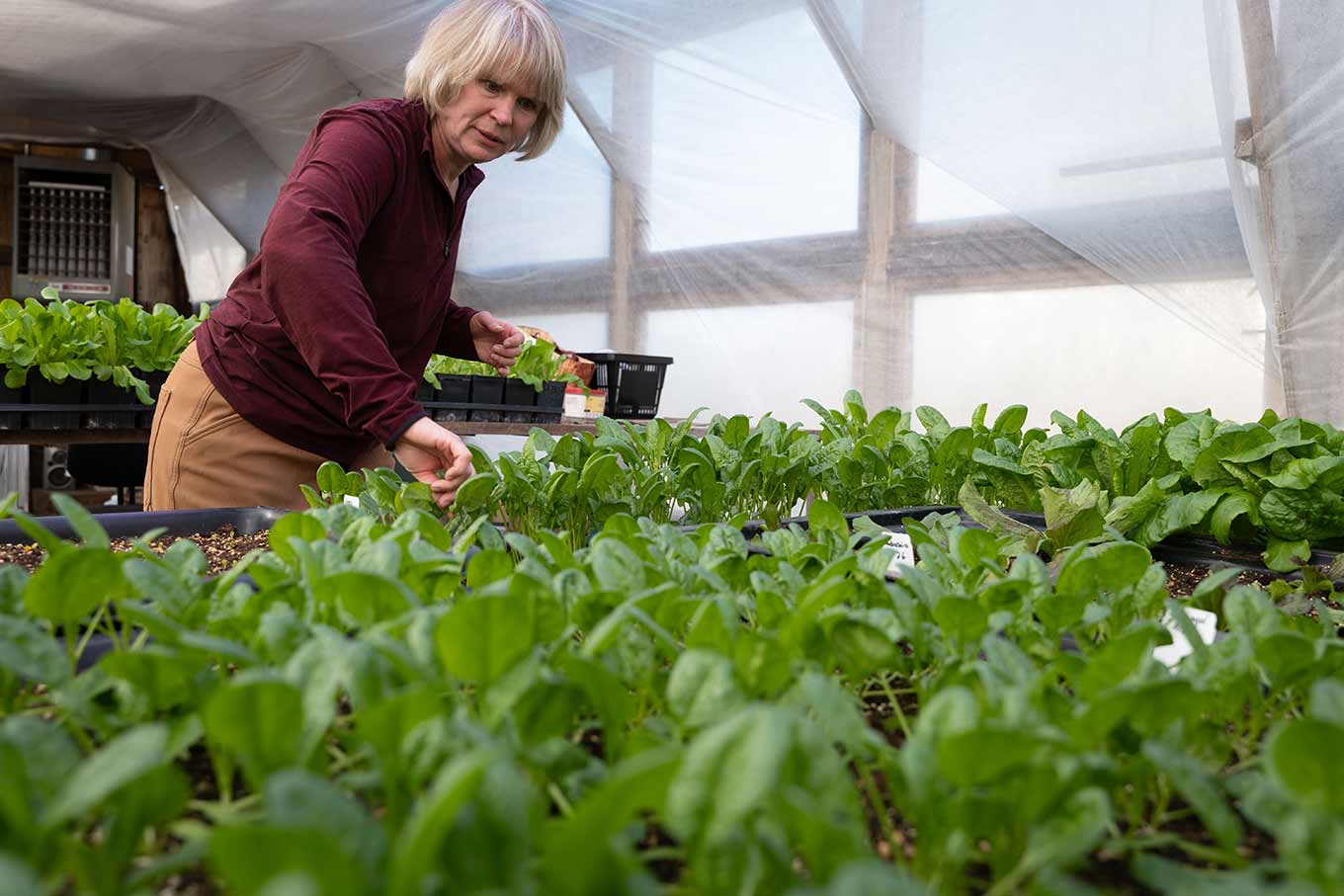The event hadn’t started yet, but the line was already several hundred people deep, snaking through the parking lot at the Mountain States Toyota dealership in north Denver on a November morning last year. Some had been waiting there for hours, braving sub-freezing conditions for the promise of free Thanksgiving dinner ingredients as part of Operation Freebird, an annual event hosted by the Adams County Sheriff’s Office that provides food and other essential resources to those in need.
When Operation Freebird officially kicked off at 10 a.m., people cheered, the line started moving, and families left minutes later toting boxes of fresh food.
“If they didn’t do this, we probably wouldn’t have anything [for Thanksgiving] because it’s really tight on cash right now,” said Cindy Esquivel, a Thornton resident who attended the event with her two grandchildren.
Inflation has been “horrible,” said Esquivel, 53, who has been out of work since having double knee surgery a year ago and is currently applying for disability benefits. For Esquivel, going to the grocery store now means paring back.
“I’m on a budget, and I have to stay close to that because I am a single grandma of two girls,” she said.
In 2021, in the wake of widespread job losses and economic hardship caused by the COVID-19 pandemic, an estimated one in eight people in Colorado and Wyoming were food insecure, according to Food Bank of the Rockies, a nonprofit hunger relief organization serving communities in both states. Food insecurity is defined as not having reliable access to enough affordable, nutritious food.
“When COVID hit, we saw a tremendous increase in need,” said Erin Pulling, president and CEO of Food Bank of the Rockies. “That need was primarily driven by people out of the workforce and unable to make ends meet.”
Now, because of record-level inflation, the need is anecdotally higher than it’s been during any point of the pandemic, said Pulling. Many of the people who Food Bank of the Rockies serves are working families who “just can’t make ends meet because of housing costs and the cost of living,” she said.
Though inflation has softened slightly from its peak in June, consumer prices in October 2022 were 7.7% higher compared to October 2021, according to the U.S. Bureau of Labor Statistics. The cost of food overall has surged 10.9%, and the cost of groceries has increased 12.4% year-over-year.
Denver resident Thomas Smith, 59, said inflation has “killed” him. It caused him to shut down his hot wings business last year, after which he and his family could no longer afford their rental house in the Sherrelwood community of Adams County. That “put us homeless,” he said, referring to himself, his wife and two teenage children, who all now live in a motel.
“Food stamps only last half the month, so we’re without for the last half,” said Smith. To fill the gap, he visits Metro Caring, a Denver-based nonprofit that provides groceries and other anti-hunger resources, such as nutrition and cooking classes as well as help applying to government assistance programs including the Supplemental Nutrition Assistance Program (SNAP, formerly known as food stamps), the Low-Income Energy Assistance Program and Denver Public Benefits Enrollment.
With inflation persisting, more Coloradans are relying on organizations like Metro Caring and Food Bank of the Rockies for fill-in support. A number of Food Bank of the Rockies’ mobile pantry coordinators have reported seeing double the number of households at distributions this year, according to a representative for the organization.
Monique Moore, a truck driver for Food Bank of the Rockies, said she’s noticed three families in particular that regularly attend most of the food bank events she delivers to throughout the week, “just so that they can stock up on food,” she said.

Crates and boxes were emptied quickly at a mobile food pantry event hosted by Food Bank of the Rockies in Lakewood on Jan. 3, 2023. Photo by Joe Mahoney / Special to The Colorado Trust
Exacerbating this challenge: Congress allowed the American Rescue Plan’s expanded monthly child tax credit payments to expire at the end of 2021. Enacted in July 2021, the expanded payments provided most working families between $250 and $300 a month, covering approximately 90% of U.S. children and leading to a historic reduction—albeit a temporary one—in child poverty rates.
Those funds were “really meaningful,” said Anya Rose, senior public policy manager at Hunger Free Colorado, a statewide nonprofit working to end hunger in the state. “Overwhelmingly, people said that they spent them on basic needs, including food, housing, child care, transportation, medicine, things like that.”
Following the child tax credit payment expiration, households with children experienced a 25% jump in food insufficiency by July 2022, according to research published in JAMA Open Network and cited in a letter that hundreds of anti-hunger groups sent to Congress requesting reinstatement of the payments.
“We’re particularly concerned about what’s coming in 2023,” said Rose. That’s because due to an ongoing public health emergency declaration by the Secretary of Health and Human Services, 30 states, including Colorado, are currently able to issue emergency SNAP allotments, meaning people who are eligible for SNAP are essentially guaranteed “at least the maximum benefit amount,” said Rose. But due to recent congressional action, emergency SNAP allotments will end after February 2023, greatly reducing payments to SNAP recipients.
For example, a hypothetical household of one will go from receiving $281 a month in benefits to $23 a month, according to Hunger Free Colorado.
“We’re looking ahead, concerned about another hunger cliff in the future,” said Rose. “Having something like the expanded child tax credit could help mitigate some of that harm.”
Having access to nutritious food is fundamental to health and well-being. “Food is an essential building block,” said Pulling. Without food security, “there are so many implications both for current day-to-day health and long-term health,” she said.
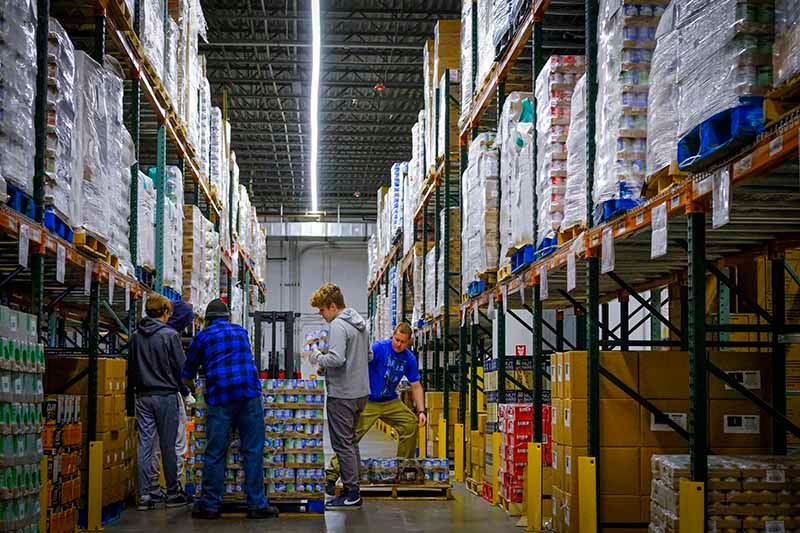
Food Bank of the Rockies volunteers and staff organize donations at its Denver warehouse on a January morning. Photo by Joe Mahoney / Special to The Colorado Trust
Food insecurity is linked with a number of health issues, including increased risk of obesity and higher rates of chronic disease among adults as well as greater risk of obesity and developmental problems in children, according to research cited by the U.S. Department of Health and Human Services. Households with people of color as well as households with children face food insecurity at higher rates than white, non-Hispanic households and households without children, according to 2021 federal data.
At Hunger Free Colorado, staff fielded 44% more calls on their hotline in October 2022 compared to October 2021. Additionally, by the end of October 2022, the number of applications they helped people submit for SNAP was 35% higher than the number of applications submitted in all of 2021, according to the organization.
When answering hotline calls, Rachel, a bilingual food assistance specialist with Hunger Free Colorado who speaks English and Spanish, hears about the impact of inflation “all the time.” (Rachel asked to go by her first name only due to privacy concerns.)
“There are families who were already food insecure who are feeling it in an even more drastic way,” she said. “And I’m also seeing an increase of families who maybe were not quite food insecure, but now with inflation have just been kind of pushed over that cliff.”
Nearly every call, Rachel hears about how the increased cost of housing in the Denver metro area is impacting an individual or family’s ability to buy food. “I hear that almost daily, I would say, if not almost every call,” she said.
Median monthly rent in Denver has climbed nearly 14% in the past three years, from $1,379 in November 2019 to $1,570 in November 2022, according to Apartment List historical data.
When it comes to food insecurity, a common misconception is that it is “specific to people who are unhoused, or that it could never affect me or my family life,” said Pulling. “What we have seen both during the height of COVID and now, is that food insecurity knows no boundaries. We have served so many people who have said something like, ‘I never thought that I would be in this position of needing help. I’ve shown up to volunteer, I’ve donated money. And here I am.’”
For instance, one of Food Bank of the Rockies’ largest food pantry partners is in Parker—a Douglas County community where the median household income is 53% higher than statewide ($114,802 vs. $75,231). Parker, said Pulling, is “an area of town that you wouldn’t expect to see high food insecurity—and yet it has tremendously high food insecurity. It just tends to be more hidden.”

Volunteers and staff at the Food Bank of the Rockies’ warehouse and distribution center in Denver. Photo by Joe Mahoney / Special to The Colorado Trust
At Evergreen Christian Outreach (EChO), a faith-based wraparound services organization in Evergreen, 30% more households visited the organization’s food pantry in October 2022 compared to October 2021. Additionally, the frequency of individual household visits jumped 37%, and the average size of a household obtaining food at the pantry climbed 41%.
In other words, “more families are coming more often to feed more people,” said Dale Flanders, executive director at EChO. On a given month, about 300-400 families visit the pantry, the majority of whom come from the mountain areas of Jefferson County, including Bailey, Conifer, Evergreen and Idaho Springs, said Flanders.
EChO relies on a combination of donated and purchased food. Because of increased visitation to the pantry—as well as the increased cost of food due to inflation—EChO spent 100% of their food pantry budget in the first three quarters of 2022. “We’ve added actually another 30% of our budget on top of that to get us to the end of the year,” said Flanders.
The surge in visitors to the pantry is directly tied to inflation, said Flanders, explaining that many of the folks who come to the pantry are on fixed incomes or in lower-paying jobs where wages haven’t increased as the cost of living has surged.
“People are having to make a choice: Can I put gas in my car, or can I get food?” said Flanders. For the majority of visitors, the EChO food pantry is a “supplemental piece” in their food procurement, he added, “but there are some that, without us, I don’t know what they would eat.”
Every couple of months, EcHO breaks their record for the greatest number of families served in a day. The current mark is 115 families, recorded in November on a Monday, the week day the pantry is open the longest. When Flanders first joined the organization two years ago, an average Monday would draw 50-60 families, he said.
At Food Bank of the Rockies, the increased number of people seeking food is also coalescing with a reduction in donated food from retailers and manufacturers due to supply chain issues and companies holding back on donations because of economic uncertainty, said Pulling. Moreover, donations from the U.S. Department of Agriculture to Food Bank of the Rockies have decreased about 70% compared to the first year of the pandemic. Fortunately, amid all the increasing costs, Food Bank of the Rockies has seen an uptick in financial donations.
The best way for Coloradans to help their neighbors in need is to donate money or volunteer at food bank events, said Pulling. With every dollar donated, Food Bank of the Rockies can distribute enough food for three meals, she said.
Back at the Operation Freebird event, which included food donated by Food Bank of the Rockies, a Thornton-based household of six picked up their fixings for Thanksgiving dinner.
“We needed an extra hand during this time,” said the father, Rogelio Munguia. “We’re just very grateful for this event.”
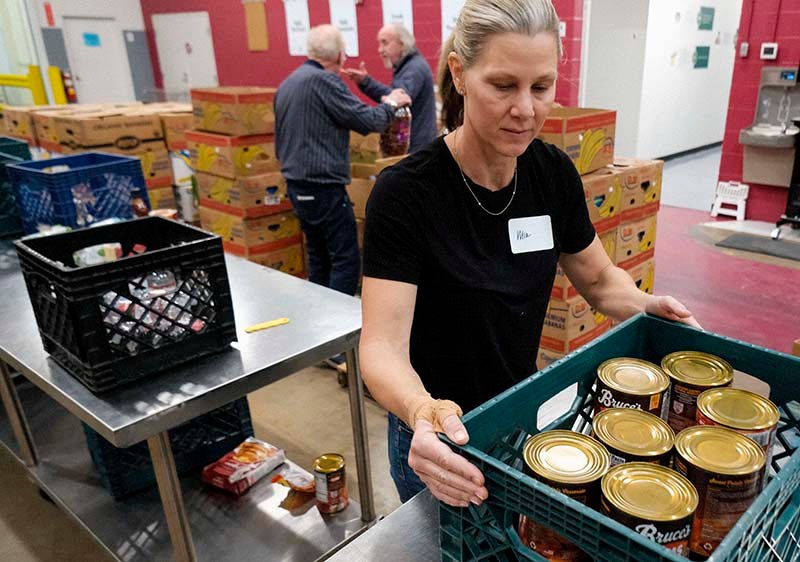
Volunteer Mia Stephenson organizes donations at the Food Bank of the Rockies’ Denver warehouse on Jan. 3, 2023. Photo by Joe Mahoney / Special to The Colorado Trust
Related story: How Much are Food Banks Worth to Some Colorado Families? Now There’s an Answer
